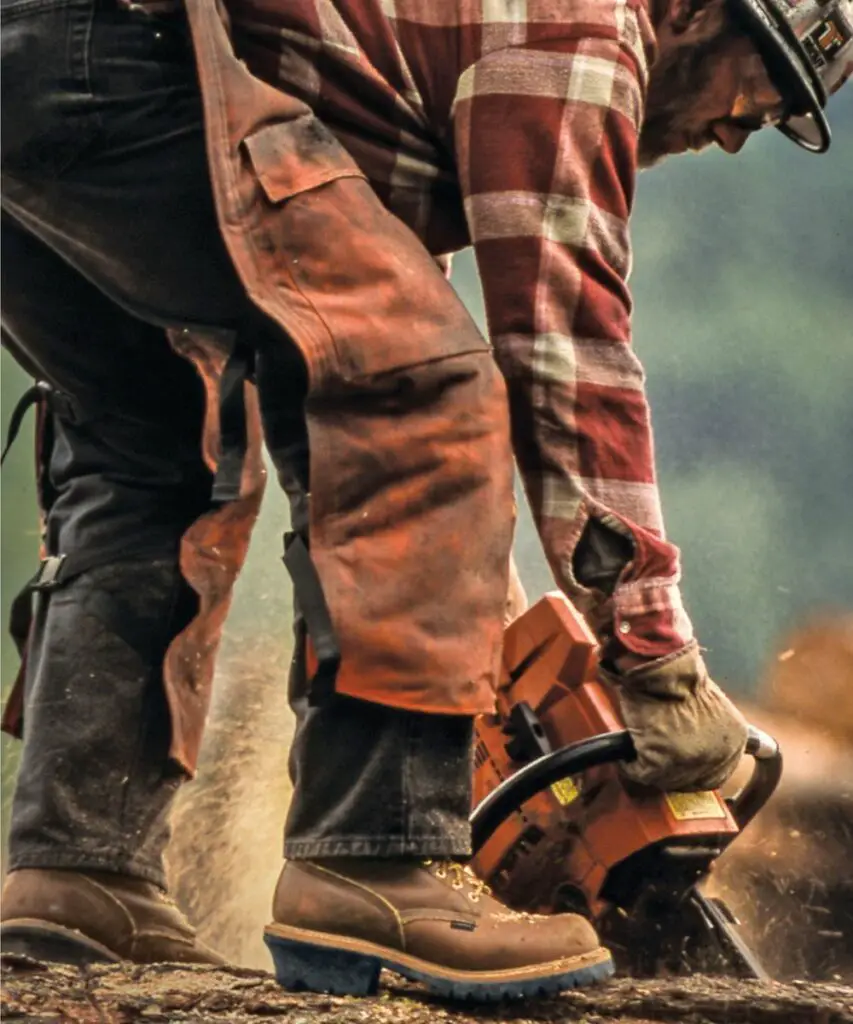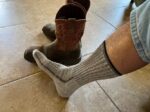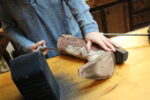
Your normal work boots cannot withstand the harsh outside elements like constant water and slippery terrains. In order to tackle these harsh conditions of weather, the boots need to have some special features!
And these features are exactly what logger boots are designed with! Logger boots have raised heels that assist in climbing slippery terrains, the traction provided by these boots is unmatched and they are built to withstand wet and marshy conditions!
When you buy logger boots make sure that they do not fit too tight especially in the ankle area as this will restrict your movement. Another thing to keep in mind is that the heel should sit exactly on your heels and your toes should not feel cramped inside the toe box.
And in this article, I am going to tell you exactly about the fittings of the logger boots, that is what fitting of these boots should you get, should they be tight or loose, do they stretch or not, how long do they take to break in, and things to consider and avoid while buying these logger boots!
So, what are you waiting for guys?
Let’s quickly head towards the details…
How Logger Boots are built? And how they Fit
Most logger boots are built using the Goodyear Welt Construction which means that the midsole, the upper and the outsole are sealed altogether in order to prevent the entry of moisture from any source!
This type of construction also ensures durability. But, along with these positive sides, there comes a negative side of this type of welt construction and that is it makes the boots stiffer than your usual sneakers.
Therefore, you need to have a proper fitting of the logger boots so that you can walk in them comfortably all day long!
Logger boots are generally somewhat stiff because of the Goodyear welt construction or the double stitching. Also, the long shafts of the logger boots that support the ankle are its unique feature.
So, keeping in mind these two features, you should consider your logger boots to fit somewhat tight when you first buy them. This is also because of the fact that loggers take a long time to break in.
Should logger boots fit tight or loose?
This is a common rule of the thumb that work boots should not fit too loose or too tight and the same applies to the logger boots as well!
Logger boots come with a lace-up system and therefore, you can rest assured that you can adjust them according to the shape and size of your feet.
That does not mean that you can buy logger boots one size up or down and then expect them to fit perfectly just with the aid of the laces! No! That is not going to happen!
Also, one more thing to keep in mind regarding the fitting of the logger boots is that they have long shafts. It means that the shaft part of the boots is going to wrap around your ankle and the portions of the leg above the ankle.
And too tight fitting of the boots around and above the ankle area will make your steps stiff and will not allow you to move freely.
Another point is that logger boots are hard wearing boots and therefore, you cannot expect them to fit comfortably the moment you buy them. They need time to break in!

Therefore, logger boots should never fit tight to your feet, instead they should offer snug fit or a bit loose fit so that you can make them as much tight you want with the help of the laces!
The heel of the logger boots should sit exactly on the heel of your feet so that you get the best balance while walking. If the heel of the boots will not fall in place with your heels, your feet will sway while walking.
Also, the toe area of the logger boots generally has steel toe caps or composite toe caps. Therefore, your toes must have enough room inside the toe box to move freely and breathe. The toes should not feel cramped inside the toe box or you will experience pain and feel uncomfortable the entire day!
Do logger boots stretch?
Logger boots are made of premium quality leather and therefore, they will definitely stretch like other boots using any of the following methods:
-
-
- You can stretch them using a boot stretcher
- You can stretch them by stuffing wet towel inside the boots and keeping them overnight so that they expand with the pressure of the towel
- Freezing the boots with water ziplocks will help to expand the toe and the heel area
- The easiest way to stretch logger boots is by spraying a boot stretching spray
- Rubbing alcohol can also help to stretch the leather fabric
- Conditioning the boots will also help to loosen the leather fibers. All you need to do is wear the boots after applying conditioner so that the boots take the shape of your feet
-
How long do logger boots take to break in?
As I have already mentioned earlier, logger boots are hard wearing boots. So, they are bit stiff in texture and that’s because they need to adapt themselves with the uneven, slopy and marshy terrains!
So, you cannot just buy a pair of logger boots and walk in them comfortably to your work. They demand a bit of time and work in order to get the perfect comfortable fitting.
Your logger boots will take as much as two weeks to one month to break in completely and naturally with regular wear. But, to your relief, there are ways to break them in faster with just some pretty simple hacks!
Let’s learn about a few of them:
-
-
- Wear your logger boots with thick socks for the first few days at home before wearing them to work
- Use leather boot oil to condition and loosen the leather fibers so that the boots break in fast
- Applying leather conditioner to the boots will also help to soften the fibers and aid in the breaking process
- Bend your boots in different directions with your hands to make them flexible. But do not go too hard with the bending movements or it might create a crack-like line on the boots
- Take the help of a boot stretcher. This is probably the fastest way to break in the hard-wearing logger boots
-
Things to consider to get a perfect logger boot fit
The perfect fit of the logger boots come with the certain special features and those are what you must be looking for while buying your logger boots:
1.) The construction of the logger boots:
The logger boots must be built with Goodyear Welt Construction because that is what speaks of the sturdy nature of the boots. If not the Goodyear Welt Construction, at least look for double welting. Double welting means using two layers of stitching to stitch the uppers of the loggers to its outsoles.
The double welt construction will help to prevent cracks in the boots which means that you can traverse uneven terrains with these boots flexibly.
2.) The lacing of the logger boots:
The entire fitting of the logger boots depends on the lacing system of the boots. So, consider buying only those logger boots that have lacing system till the opening of the boots. This will help to adjust the fitting of the boots according to your wish.
Also, choose the boots with sturdy eyelets like those which made with nickel or brass. Better if the laces are made of synthetic material because those are considered to be sturdier than the cotton ones.
See also: How to tie logger boots
3.) The shank of the logger boots:
Look for a supported shank in the logger boots. This will help to keep the ankle supported while treading high and uneven terrain. The ones that do not have a good shank support will be uncomfortable for your ankle area.
Look for composite shanks instead of steel shanks for a more comfortable fit.
Things to avoid while buying logger boots?
There are certain things which you should strictly avoid while buying your pair of loggers:
-
-
- Do not buy the loggers that don’t have lugged soles. Better go for the ones that have hobnails
- Do not buy the logger boots that do not have shafts that are less than 9”
- Do not buy logger boots that do not have Goodyear welt construction
- Do not buy logger boots that have pointed toes
- Do not buy logger boots with heels less than 2”
-
It’s time to bid Adieu!
That’s all for a perfect fitting of the logger boots!
Taking leave from here with the hope that you enjoyed reading my article.
Stay tuned for more useful tips and tricks on boots and other work wears!
Till then, take care, stay safe and have a great day ahead!








